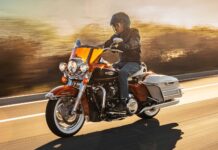
I have privately wondered at times if I am a bike guy due at least in part to economics. Bikes are generally less expensive to buy and to restore than cars are and they definitely take up less garage space. During good times I have hauled home four or five bikes at a time in my pickup truck and laid out less than five hundred bucks. That’s pretty economical, even for parts bikes.
Compounding this introspection was the recent auction of the cars of the late Dr. John Mansell who lived in the quaint, nearby college town of New Wilmington, Pennsylvania. I’d heard rumblings of the collection and the impending auction for months before it actually took place and one day while in New Wilmington I stopped by the old car dealership that reportedly housed some of the good doctor’s collection to see what I could find out. I was not disappointed as the very first car to greet me after I was let inside was a 1953 Corvette. Now, even non-car people should know that 1953 was the very first year for the legendary Corvette and this one, though kind of rough, was complete, had the original Blue Flame six-cylinder motor and was reported to be the 175th ‘Vette ever made. That’s when I learned that the doctor’s entire collection included 108 cars ranging from the 20’s to the 90’s and plenty of parts to fix them with. It was highly unusual for such a collection to exist in this area. Doc had accumulated the cars, a large portion of them convertibles, over the last 50 years or so, paying a very modest price for many of them with the intention of saving them from the crusher. They were stored inside a barn. Not an elaborate building designed to look like a barn, but an actual barn.
When auction company Joe R. Pyle came to town to prepare the collection for sale, the cars were spread out with only the most exclusive of the convertibles staying inside the barn. The auction was quite an event with a preview on Thursday night followed by two days of auction. My dad and I went to the preview and Dad was largely unimpressed. Many of the convertible tops had dry rotted over time, allowing all manner of vermin to make their homes in the vintage interiors, which were much the worse for wear. Serious buyers crawled over, under, around and inside the cars, noting the condition issues and potential expenses that would be involved in restoring these diamonds in the rough.
I returned for the auction, which required parking at the local college and being shuttled to the property via school bus. School buses, it should be noted, have downsized their interiors since I was last on one, leaving plenty to be desired in the area of passenger comfort. Once on site, there were big top tents, big screen TVs to see the auction items, and large fans to keep us comfortable.
The ‘Vette hammered for $170,000, but many of the cars were much more affordable, ranging from $8,500 for a ’73 Mustang convertible with 53,000 miles on the clock to a ’53 Ford Crestline convertible Indy Pace Car optioned for $9,000. On top of that would be a buyer’s premium of between 10 and 15 percent depending on your payment method, and all but a handful of the cars would need to be towed off the property.
You would think that anyone who collected this many convertibles would have had a weak moment somewhere along the way and bought a motorcycle. I say this because a convertible enthusiast must enjoy at least some of the feeling that we enjoy on motorcycles. The smells, the wind, and degrees of the freedom of the road are all things that are appeal to both motorcycle riders and convertible drivers. But no, not one bike snuck through the auction line which has led me to the conclusion that the reason I love finding and restoring old bikes instead of old cars is something more than pure economics. I think motorcycles represent minimalism—transportation with the least number of wheels and simple mechanicals that lend themselves to shade tree mechanics like me. It doesn’t hurt that they are less expensive; you can haul a broken one without calling a tow truck and they fit neatly into the corner of the garage, but that is not the only reason guys like me love them.
Dr. Mansell’s car collection is now scattered across the world, leaving behind New Wilmington and the sound of the area’s Amish population’s buggy wheels rolling past. But the cars came together from across the U.S.A. and it seems fitting that they are free from the confines of the barn and years of dust and dirt and on their way to being truly saved and enjoyed on the open road again. And that’s really all Dr. Mansell ever wanted. I laid out 35 big ones for a plastic Indy car model at the auction. They don’t take up much space either.




















Hi, which of the models did you purchase?
I am from the UK and bought the 68 Torino Indy pace car convertible, Dr Mansell bought the car new and used until 1974 when it was put away in the barn. The car was actually used at Indianapolis in 68 for transporting CBS television film crew. also transported some of the top race car drivers between the raceway and motel, including Bobby Unser, Johnny Ruterford, and many others , a letter from the editor of CBS Television/radio confirms this, he was given the car to use in weeks prior to the race. Car was also used on the raceway for some filming. Car also came with unbeleivable documented history file including letters from Ford, order sheet, build sheet, window sticker, original invoice and insurance papers, newspaper clips from 68, and much much more, it was the history of the car backing up what it was together with all the documentation and coming from the original owner that did it for me, car still has the original plastic on the seats and i beleive animals had not got in the car. Car should arrive in the UK in approx. 2 weeks time, i have not seen it yet but has been described to me by several people!
Paul.